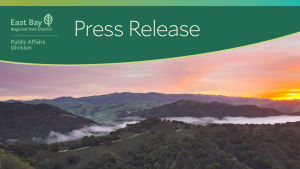Park District Invited to White House Water Summit
The East Bay Regional Park District has been selected as one of the few land agencies – and one of approximately 200 committed organizations - in the United States to participate in this week’s White House Water Summit to commit to addressing water challenges and solutions in the age of climate change.
Park District General Manager Robert E. Doyle will attend the March 22 event in Washington, D.C., highlighting the Park District’s leadership in preparing for drought, El Nino and water policy issues over the past several years.
“We’ve committed extensive resources to address water-related issues, and this is a great opportunity to share our expertise,” Doyle said. “We’re tremendously honored to be included in this important event.”
The largest regional park system in the U.S., the East Bay Regional Park District encompasses 120,000 acres, 65 parks and 1,250 miles of trails. Its scope includes more than 40 miles of shoreline along San Francisco Bay, Carquinez Strait and the Sacramento-San Joaquin River Delta, 10 lakes and countless streams, seasonal creeks and wetlands.
“The Park District has taken on a leadership role, not only to respond to the state’s 25 percent water-use reduction goal, but to implement strategies to make our parks and communities more resilient to the consequences of our changing climate,” Doyle said. “We are proud to be recognized by the White House for our leadership.”
During the drought, the Park District reduced water use, promoted water conservation and adapted to a drier landscape by:
1 Replacing lawns with native and drought-tolerant grasses, and installing “brown is the new green” signs.
2 Switching to more efficient irrigation systems and studying the use of reclaimed water.
3 Thinning vegetation, especially eucalyptus and other non-native trees, to reduce wildfire risk.
4 Regularly testing, publicizing and treating drought-triggered toxic algae in our lakes.
5 Using interpretive gardens and educational signs to encourage the public to use less water at home and replace non-native plants in their gardens with natives. The Park District’s Botanic Garden has the state’s largest collection of native plants.
6 Taking special steps to save amphibians and other water-dependent species by monitoring their populations and protecting their breeding areas.
7 Restoring hundreds of acres of wetlands to create a buffer against sea-level rise.
As part of its ongoing efforts to respond to climate change, the District has also reduced energy use, promoted regional trails as an alternative to driving, provided free environmental curriculum to low-income children, and continues to study carbon sequestration.
The White House Water Summit, held in conjunction with the United Nations World Water Day, will focus on long-term strategies to build a sustainable and secure water future through innovative science and technology.
As part of its involvement with the event, the Park District has agreed to set a goal of saving 250 million gallons of water over the next five years. As part of this effort, the Park District plans to eliminate some standard grasses in high-use areas and replace them with drought-tolerant grasses, and seek partnerships with local sod and seed companies to make drought-tolerant grasses available to the public. We also plan to convert a number of grass areas into native plant gardens for water-efficiency and public-education purposes. We expect these initiatives will cut water use by 30 to 50 percent and reduce lawn-mower emissions by 50 percent.
The White House Water Summit will be livestreamed on www.whitehouse.gov/live, and we invite you to participate using the hashtag #WHWaterSummit. For inquiries about this event, please contact env_energy@ostp.eop.gov.






